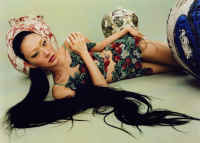Artist and Creative Director Hassan Rahim Always Begins By Asking “Why?”
Pursuing Meaning with the Graphic Designer Who Doesn’t Work Mondays
- Interview: Durga Chew-Bose
- Photography: Naima Green
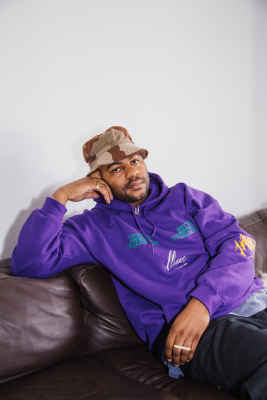
“This is going to end up in the piece,” says Hassan Rahim, laughing. He changed the volume five times in three minutes. Originally from Los Angeles, but now based in New York, we’re sitting in Rahim’s Brooklyn studio, where the artist and creative director is trying to pick a song. He’s trying to find the right volume. Everything needs to be just so. These little adjustments, I come to learn, are part of Rahim’s process, who approaches every project—like the conversation we’re about to have—with a disproportionate ratio of set-up time to actual output. (A great thing!) Thought, care, the right song, tending to tangents, deliberating as a Gemini, or allowing for ideas to accrue and connect over time, are tenets of Rahim’s practice, more crucial than productivity for the sake of it. This level of consideration (less methodized, mostly instinctive) works well for Rahim, who in 2016 founded 12:01—a full-service creative studio with clients that include, among others, Nike, Warp Records, Sony Music, and Willo Perron.
Rahim’s collaborations with brands and artists (like Kahlil Joseph and Marilyn Manson) are marked by stark visuals, somehow haunted in nature, layering imagery so as to capsize context. His work for Total Luxury Spa, the popular L.A. streetwear brand, counts everyone from Kyrie Irving to Kelsey Lu, Ari Marcopoulos and Lil Miquela, as fans.
We met at Rahim’s studio to talk design, procrastination, and not taking yourself too seriously.
Durga Chew-Bose
Hassan Rahim
How do you choose which projects you’ll work on? What’s your criteria?
Gut. And I love versatility. Maybe it’s part of being a Gemini. Different range is what makes anybody good, you know? There’s so many people that want to be a specialist in one thing and that’s awesome. Going to Tokyo was really eye-opening. Someone dedicated their whole life to opening a restaurant themed around cows.
Cows?
Cows. You know, like hyper-specific. I'm interested in too many things to do that. I think it's important to collaborate. I don't want to work alone all the time. That's why I always work with different designers and different people. The only constant is what I put into it. A lot of people like to do stuff themselves, and a lot of creative directors actually do this to really claim more ownership. I'd rather give the credit to everybody. I'd rather build a team and everyone contribute something good. Non-monogamy in work is important. People naturally move in all directions. Everyone is like, “Oh first I did a podcast. Then I just picked up photography and now I restore cars.”
I feel like we're a project generation.
Yes. Not career-oriented. It’s all just so fluid. Nothing's linear and that's the way people think, too. It’s like bubble thinking, not linear thinking. Because of the way we use our devices and stuff, I don't know anybody who doesn't have a really bad attention span. It’s all related.
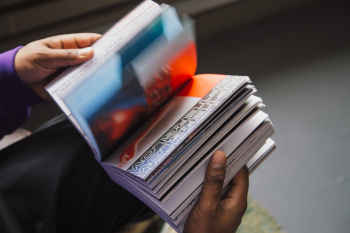
When you’re collaborating with a lot of people on a project, how much of your energy are you preserving for when you go away and actually have to do your thing? Is your process more about volleying ideas back and forth and working at the last, last minute?
That’s a good question. I like personal space because I need to essentially silo. That’s where my best work comes from. That’s the healthiest state of mind for me. If I’m doing art direction or creative direction, there’s a team of people. I’m always sketching ideas or building directions, or passing it off to people then passing it back. A lot of it is creating situations.
But when does the work happen?
That's literally the biggest hurdle of my life. I end up working all night. I’m a night owl. That's when I can actually throw on some two-hour or four-hour-long mix, or I'll put on NTS Radio and just zone out. Oh, and one thing, I don’t work Mondays.
You’re like a gallery.
I’m like a Jewish deli. I’m just like, “We’re closed Mondays.”
“Closed Mondays” sounds like the name of a studio.
Yeah, yeah. That’s a good one. That might be my first monograph.
Are you possessive of your designs? Of your signatures?
No, I don’t think so. I approach everything differently. My lifetime goal is that I have an authorship. There’s a little bit of subtlety and weird decisions that I think are becoming signatures that aren’t necessarily specific ideas or aesthetics, and that’s something I try to retain. As long as I’m successful in trying to achieve that, I’m never possessive.
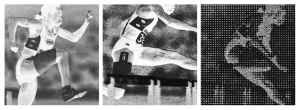
The New York Times, photo illustration about the challenges of being Black in America, featuring Olympian Jackie Joyner-Kersee.
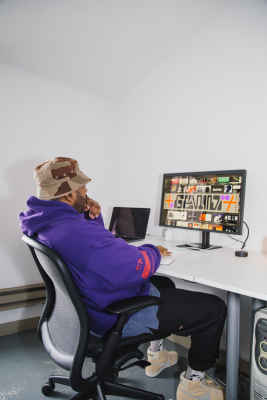
What are some of your design signatures?
Inversion, subversion, in my eyes, is like a metaphor, it’s about flipping something on its head. That’s my signature, in a way. It’s about a literal “Let’s turn it upside down and take a look at it again.” Kind of like squint and see what it does. I’d rather leave people asking more questions than having answers. I think a good example is the illustration I did for the New York Times. The story was about the writer’s dad giving her the talk about how hard it’s going to be growing up Black. And I was like, “What if we literally had someone jumping over hurdles?” So I made a three-sequence image of Jackie Joyner-Kersee jumping over hurdles that gradually degrade as she completes the task. It’s about fatigue and accomplishment.
Let’s talk about the "why” of your work.
It’s the first question I ask myself. Whether I ask the client or I ask anybody else on the project. It’s “Why?” I keep pushing more and more for things to have meaning and have more impact. You don’t always have to be conceptual and serve a purpose, but I’m drawn to that. But more recently, with so much social anxiety, and also, this political climate—this combination of things being so hectic—I think it’s also okay to just put something on a t-shirt for fun without needing a fucking purpose.
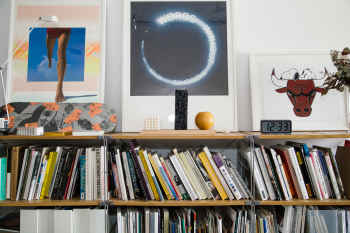
Is there a reason you have nothing on the walls here in your studio?
It’s a lot of commitment to hang a picture. I just think more clearly like this. I have a couple things, but they are more reminders. I like the Ed Ruscha [which reads “Words Without Thoughts Never To Heaven Go”] because it’s like an academic-inspo quote. It’s motivational. A reminder to think about what I’m doing or saying.
What about the dead flowers on your bookshelf? What’s the story there?
That bouquet died and dried up in such a beautiful way that I just kept it. I had bought it for a meeting. I did a book for Jason Moran, for the Walker Art Center and the design director from the museum came, flew in direct, straight to my studio to meet about the book. I wanted [the studio] to look nice, you know what I mean? Candles and stuff. [The meeting and the book] turned out amazing. But at the time I was going through a really crazy depression episode. So this bouquet died, and I just kind of kept it there as a reminder.
It’s beautiful.
And there’s the “Snoopy-Chicago Bull.” It’s like a self-portrait. It’s the most Gemini picture, too. Because that shit’s both my moods. I grew up a huge Michael Jordan fan; everyone wanted to be like Mike.
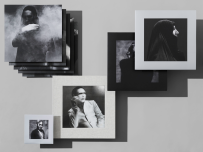
Marilyn Manson art direction, design and identity for The Pale Emperor album campaign. Photography by Nicholas Alan Cope, Creative direction Willo Perron.
How long have you identified with being a Gemini? How long has astrology played a role in your life?
It became a thing in the last three years. I went through a pretty serious breakup and that breakup was a big paradigm shift in everything in my life. I needed to be more spiritual and more introspective. I found astrology to be really helpful. I like blaming it for some of my faults. I like to hold it accountable. [Laughs]
With work, how hard are you on yourself?
I’m super hard on myself. Actually, that was one of the crazy things about one project I worked on last year. I held myself to such a high standard that I froze. I couldn’t even get out of bed to work on it. You know, with trauma survivors, there’s fight, flight, or freeze. And [my therapist] was like, “You’re a freeze person. Like a deer in headlights.” I think about things so much. Like 20% of my work is actually me physically doing it and making it. And 80% is just me thinking about it for weeks, days, months, nights and weekends.
Same.
It’s funny. I was watching a TED Talk about procrastination and how procrastinators are the most conceptual people. Most artists are procrastinators. Sometimes you need the pressure and you need the extra time. It just needs to be in the back of your head. You’re not the person who’s like, "We're going to do this thing. Great." You're like, "No. I need to really mull it over." I actually started reclaiming that. So my bio on Instagram is “Never on schedule. Always on time.”
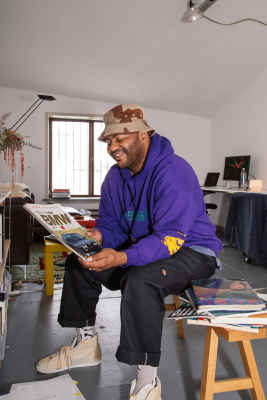
I taught a writing seminar at Sarah Lawrence about the virtues of procrastination.
Oh really?
Mm-hmm. It was called “On Not Writing.” I encouraged the students to procrastinate. I encouraged them to binge-watch Netflix on weekends. Some of the best writing came out of that sort of stuff. The seminar wasn’t a hit with the whole class. There were skeptics. But there were some students who, it felt as though nobody had ever encouraged them to pause and look around, and put things off a little. Because that’s the work, too.
Yeah and I think creative types are oftentimes so misunderstood by the get-shit-done types. I have an issue with people where I’m like, “It’s not as simple as delivering the thing.” If you want that, you probably have the wrong guy. I’m not a gun for hire. Even this conversation with you, I consider this part of the work. All of this stuff is part of the greater experience.
Durga Chew-Bose is the Managing Editor at SSENSE.
- Interview: Durga Chew-Bose
- Photography: Naima Green
- Images/Photos Courtesy Of: Hassan Rahim

